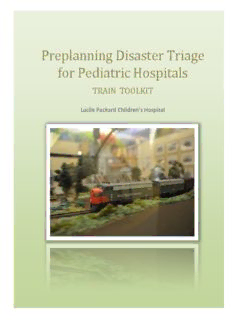
Preplanning Disaster Triage for Pediatric Hospitals PDF
Preview Preplanning Disaster Triage for Pediatric Hospitals
Preplanning Disaster Triage for Pediatric Hospitals LucileT PRacAkIaNrd C ThiOldOrenL’Ks HIoTs pital Table of content Introduction 3 TRAIN Matrix 4 Definitions of Categories 5 Instructions Physical 9 Computerized 12 References 14 Appendix A TRAIN Assessment Form Appendix B 1. TRAIN Self-assessment tool: Case Studies 2. Answers to Case Studies Appendix C Education What is TRAIN? (for administration) 2 INTRODUCTION The Triage by Resource Allocation for IN-patient (TRAIN) matrix is a tool for pediatric hospital disaster “pre-planning”. It categorizes pediatric inpatients according to their resource transportation needs during an evacuation or mass casualty event requiring increased surge capacity. This tool can be implemented manually or within an electronic medical record. It accurately assesses patients quickly and easily to determine transport needs, which allows institutions to request and receive resources required for vertical movement in disaster. This innovative tool applies to hospitalized patients with regards to their current resource transportation needs. Previous triage tools are primarily used in the pre-hospital setting and are based on severity of illness or predictors of 1-3 mortality , which are not applicable to the inpatient population. This tool is most effective when incorporated into daily practices prior to a disaster. 4 This tool was originally created for the neonatal population and then modified for hospitalized pediatric and obstetrics patients. There are also future plans to incorporate the adult inpatient population. 3 alized nstable obile TPN/IL p > 2 < 1500 Speci Max-U Imm NPO & IV dri ube, wt . t c t et hes rt, c a RIX nts [TRAIN] © Critical Care Moderate-Stable Transport rig NG/PO + TPN/IL IV Drip x1 c. w, Externally paced, NO, CVVH, Berlin He traints g to ambulance osurgical/bariatric LPCH TRAIN MAT Triage by Resource Allocation for IN-patie Car BLS Stable Minimal Car/Carseat Wheelchair/stretcher PO Feeds PO/NG PO Meds PO Meds/IV Meds/IV Fluids Minimal = Hood or Low Flow Cannula O2, Peritoneal Dialysis, et Moderate-Stable = Conventional Ventilator, CPAP/BiPAP/Hi-Florams, etc. Max-Unstable = Highly specialized equipt., e.g., HFOV, ECMO, i ar/Carseat = able to ride in automobile with age-appropriate res ransport rig = age-appropriate rig with equipment for connectin mmobile = Unsafe to move without special equipment e.g., neur g C T I t t rt or y n cy or y o p t o a p t p p li ti m p li s u i i u i Tran ife S Mob Nutr Phar ife S Mob L L BLUE Transport: Car or Bus Life Support: Stable • No need for monitoring* • Room air • Uncomplicated drains (ie: bili or JP drains) Mobility: Car/Carseat • No specialized equipment needed to transport patient Nutrition: PO Feeds • Oral feeds only • No tube feeds Pharmacy: PO Meds • Oral meds only • No intravenous medications *These patients may be considered for transport by car/bus or for discharge home in the setting of a disaster in which altered standards of care are present. 5 GREEN Transport: Ambulance (BLS/ALS) Life Support: Minimal • Low flow cannula or hood oxygen • Peritoneal dialysis (intermittent) • May require cardiorespiratory monitoring Mobility: Wheelchair/stretcher • Baseline requirement (cerebral palsy) • Restricted mobility due to devices (ie: spica casts, traction, halos, etc) Nutrition: PO/NG • Oral feeds in combination with tube feeds (ie: G-tube, nasogastric, nasoduodenal, nasojejunal, orogastric) Pharmacy: PO Meds/IV Meds/IV fluids • Intermittent intravenous medications • Standard IV fluids (ie: dextrose with electrolytes, etc) 6 YELLOW Transport: Critical Care • Ambulance with RN +/- RT +/- MD Life Support: Moderate-stable • Conventional Ventilator • CPAP/BiPAP/Hi-Flow/Continuous Nebulizer • External pacemaker • Chest tube • Weight < 1500 grams • Etc. Mobility: Transport rig • As based on equipment required to safely transport patient Examples: external ventricular drains, etc o Nutrition: NG/PO + TPN/IL • Combination of enteral feeds (by mouth or tube feed) and parenteral nutrition (total parenteral nutrition/intralipid) Pharmacy: IV drips X1 • Can have intermittent intravenous medications • Single intravenous medication drip (ie. Insulin, basal narcotic drip, pressors, etc) 7 RED Transport: Specialized • Ambulance or Military –supported transport with combination of multiple RNs, likely with MD and RT Life Support: Max-Unstable • Highly specialized equipment High Frequency Oscillatory Ventilation o ExtraCorporeal Membrane Oxygenation o Inhaled Nitric Oxide o Continuous Veno-Venous Hemofiltration o Ventricular Assist Devices o Etc. o Mobility: Immobile Nutrition: NPO & TPN/IL • No enteral feeds • Parenteral nutrition only Pharmacy: IV drips ≥ 2 • Can have intermittent intravenous medications • Multiple intravenous medication drips (ie. Insulin, basal narcotic drip, pressors, etc) 8 PHYSICAL ASSESSMENTS USING THE TRAIN MATRIX 9 Daily Process 1. Assign one person daily to complete the TRAIN assessment form (see addendum A). a. This individual may be whoever you decide is capable of completing the process accurately (i.e., Staff Nurse, Charge RN, Nurse Manager, Physician). b. The accuracy of this tool is best when administered by someone familiar with the patients. 2. Enter each of the Unit’s bed numbers on the TRAIN assessment form. 3. Enter the name of the patient occupying each associated bed space. 4. Complete the information, including: 1) Date, 2) Time, and 3) Unit 5. Assign the appropriate color to each patient, according to the TRAIN matrix. 6. At the bottom of the table, total the number of patients in each TRAIN category 7. Have the TRAIN matrix and completed assessment forms readily available with disaster plans on your unit. 10
Description: